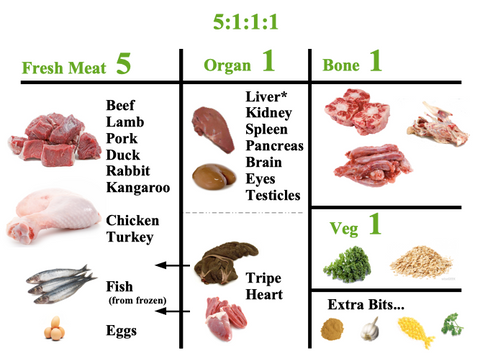IMPORTANT NOTE: Before starting your dog on a new diet, especially a raw food diet, consult with your veterinarian.
Kibble, fresh food, raw food, oh my! When it comes to feeding our dogs, there are so many options! You want to feed your dog the best possible diet to optimize their health, which raises a lot of questions.
There’s a lot of chatter about raw food for dogs lately – some in praise and some in criticism. So what’s the deal here? We’ve done the research to gather the truth about raw food diets. And since we don’t believe in gatekeeping when it comes to what’s best for our pets, we’re sharing with our Miminko Fam!
WHAT IS A RAW FOOD DIET?

Raw food diets are pretty much what they sound like. The focus is on feeding your dog food that is not cooked in a traditional sense.
Raw food can be homemade or store-bought, fresh or freeze-dried. While there’s some variation within raw food diets, they mostly consist of similar ingredients:
- Muscle meats
- Whole or ground bones
- Organ meats such as livers and kidneys
- Raw eggs
- Fresh fruits and vegetables
- Dairy such as yogurt
Raw food diets have been around for a really long time for racing and sled dogs. It was then introduced as a concept for family dogs in 1993 by Australian veterinarian Ian Billinghurst.
His thought process was that all adult dogs would thrive on a diet based more on what they ate before domestication rather than commercial dog food.
Fun fact: Billinghurst first referred to this diet as the BARF diet (Bones and Raw Food or Biologically Appropriate Raw Food) – but this nickname didn’t quite stick because of its ~less than appealing~ nature. 😹
BENEFITS OF RAW FOOD FOR DOGS?

Image sourced: Raw Paws Pet Food
When raw dog food is prepared correctly, there can be benefits, like:
- Stronger bones and joints – The bones included in a raw food diet contain collagen, marrow, glucosamine, and calcium which support bone and joint health.
- Cleaner teeth – Chewing on bones can help your dog remove plaque and buildup from teeth. A highly processed, high-carbohydrate diet can contribute to poor dental health in some dogs.
- Softer, shinier coats – Many raw diets contain food rich in omega-3 fatty acids (salmon, seeds, etc.) which support healthy skin and soft, shiny coats.
- Reduced stool volume – The ingredients of a raw food diet are typically more digestible and contain no fillers, so to put it bluntly, there’s less extra stuff for your dog to poop out.
- Higher energy levels – A diet rich in protein, vitamins, and minerals and low in fillers can help your dog use energy more efficiently.
RISKS OF RAW FOOD DIET FOR DOGS?
- The possibility of bacteria in raw meat that could make your dog (and the human serving them) sick
- The potential for an unbalanced diet that may lead to nutritional deficiencies over a long period of time
- The risk of bones casing broken teeth, internal punctures, or choking
The risk of food-borne illness increases significantly when raw food diets are prepared from unregulated or unknown sources without proper health and handling guidelines.
So if you’re preparing your own raw food diet or purchasing from an unregulated source, you and your dog may be at higher risk.
- Some veterinarians also warn that raw diets can be potentially harmful to dogs who share their homes with young children or immunocompromised people – or if the dogs themselves are young puppies or have conditions like pancreatitis, cancer, or other diseases affecting the immune system.
To summarize: the biggest concern about a raw food diet is the potential for contamination and food-borne illness for the dogs and people in your house. Young children, puppies, and dogs/people with immune-compromising conditions are at an increased risk.
Here are a few other things to consider before starting a raw food diet for your dog:
- Your dog’s specific health needs. As we mentioned earlier, a raw food diet may not be appropriate for dogs with liver issues, pancreatitis, digestive issues, cancer, or autoimmune issues. Make sure to consult your vet before making any changes to your dog’s diet, especially if they have any of these conditions.
- Your dog’s age. Young puppies are more at risk for issues associated with raw food, so it should only be introduced to older dogs.
- Make sure your veterinarian is familiar with your dog’s health baseline that way you can more easily spot any changes or issues that arise because of diet changes.
- Proper handling and cleaning requirements are non-negotiable. You need to be 100% sure your dog’s food was handled properly and safely before feeding it to them.
We hope this helped you figure out if raw food is right for your furry bestie.
SOURCES:





